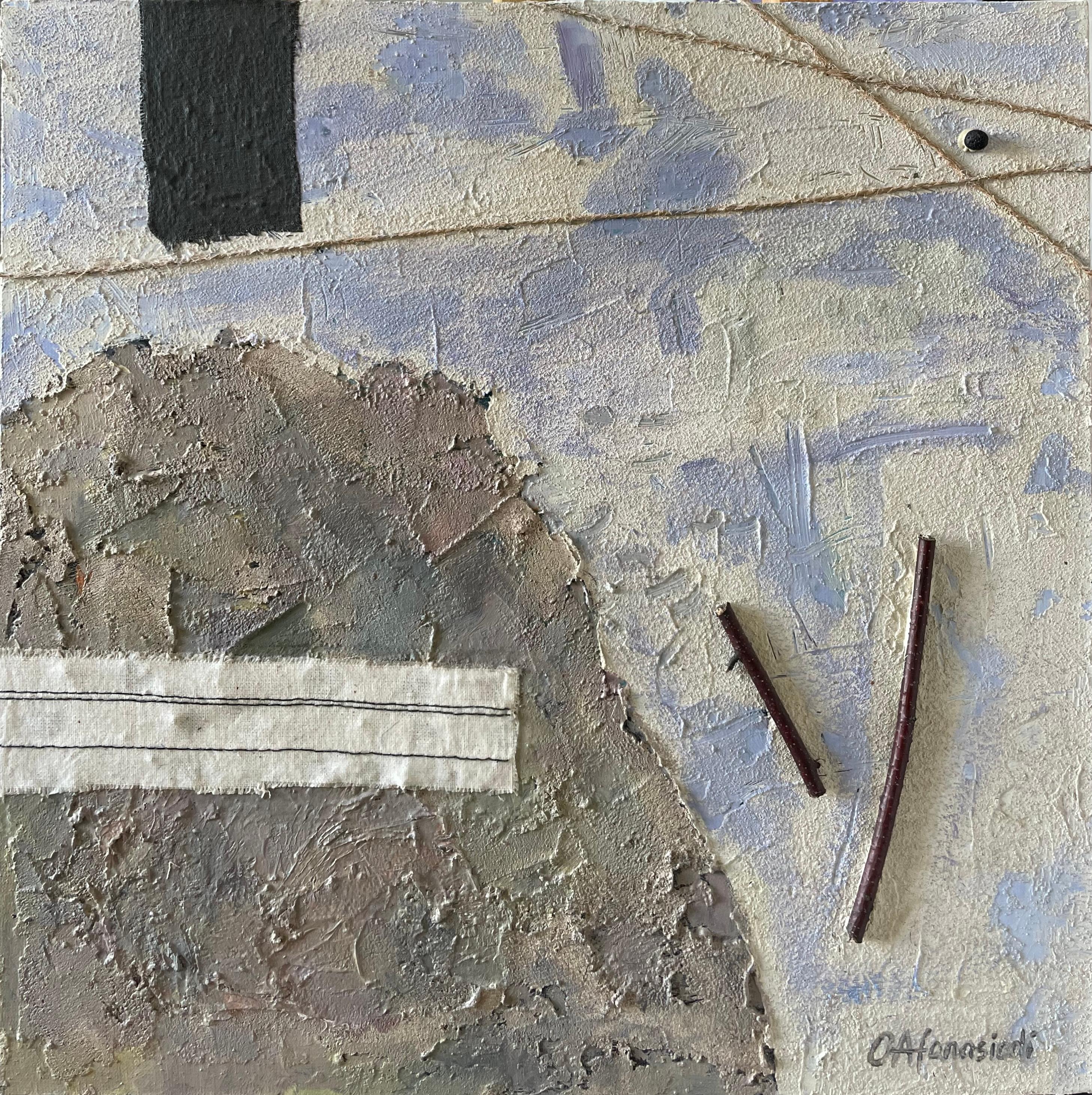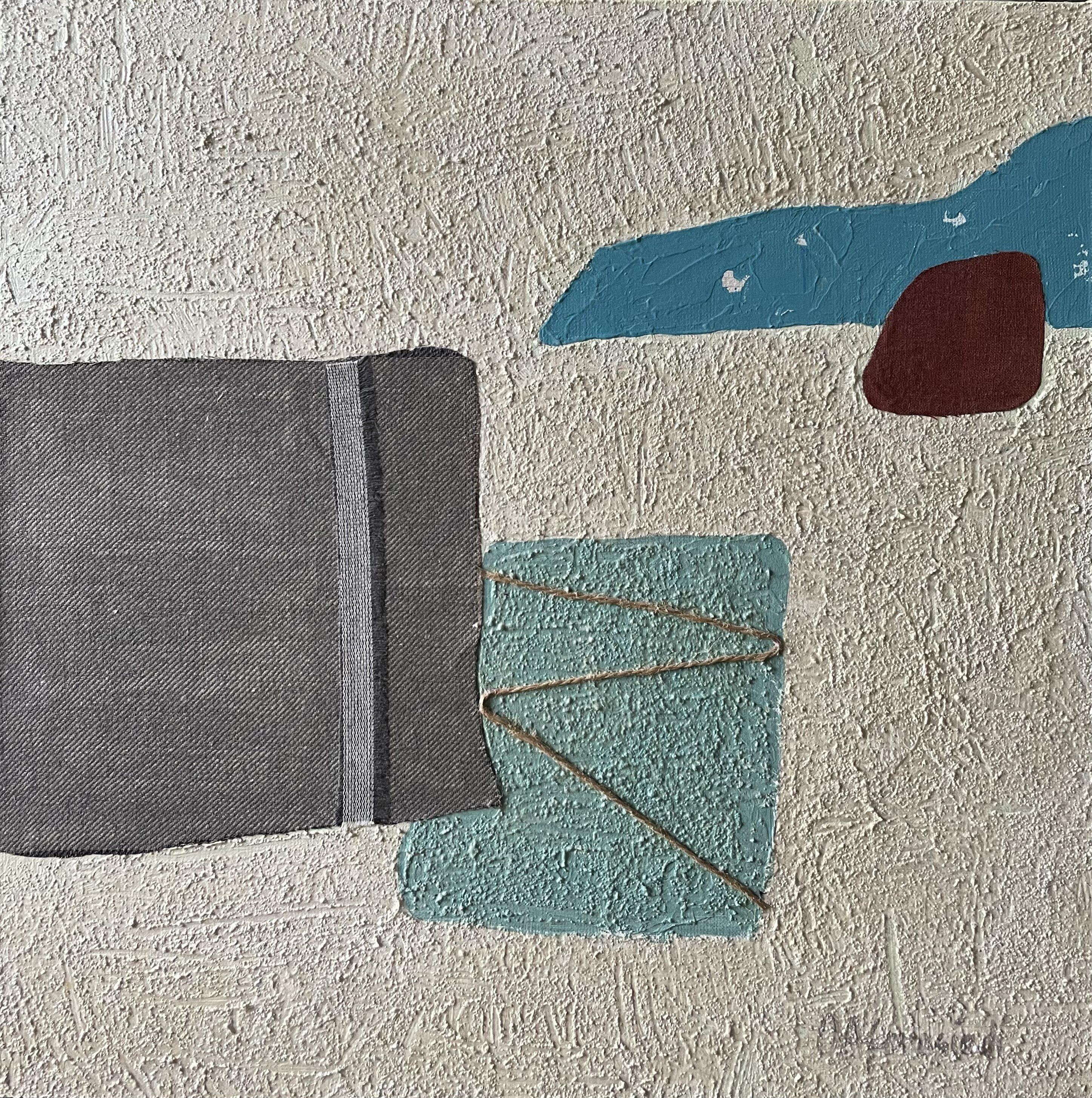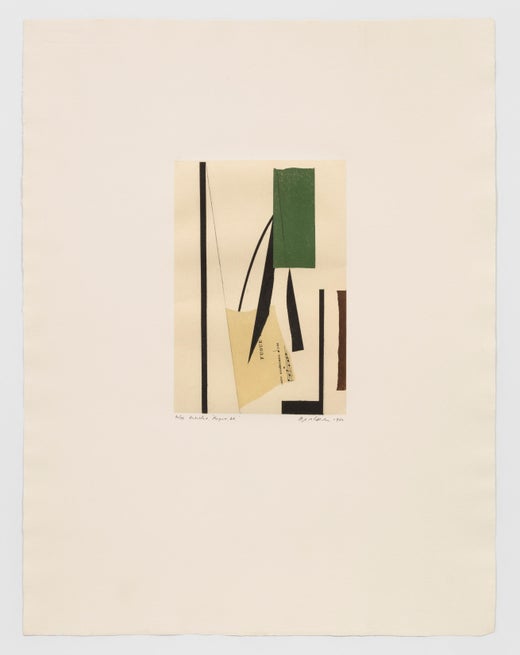Items Similar to "Ouverture, with Cypress Forms" Stephen Edlich, Abstract Geometric Painting
Want more images or videos?
Request additional images or videos from the seller
1 of 11
Stephen Edlich"Ouverture, with Cypress Forms" Stephen Edlich, Abstract Geometric Painting1982
1982
About the Item
Stephen Edlich
Ouverture, with Cypress Forms, 1982
Signed, dated and titled on the stretcher
Acrylic paint, mixed media, and burlap on canvas
60 x 40 inches
An artist who worked in the post-cubist and constructivist traditions, Stephen P. Edlich gained a considerable amount of acclaim in the 1970s and 1980s for his collages, sculpture, and paintings. His promising career was cut short due to his untimely death at age 45 in 1989.
Edlich was born in New York City. He received his undergraduate degree with a major in fine arts studies from New York University in 1967. During his college years, he traveled to London, where he met the art dealer Victor Waddington and created his first white on white collage. In that same year, he attended a major exhibition of the work of Ben Nicholson, which would be influential source in his art. Edlich returned to England in 1967, where he met Barbara Hepworth and Patrick Heron in London and traveled to St. Ives, Cornwall, long a favorite artists' haunt. Edlich began creating acrylic reliefs in 1967. In the following year, he began a master of arts program in sociology at the New School for Social Research in New York, but continued his art career, completing a series of bronze reliefs at Columbian Art Metal Works, New Jersey.
Edlich had first solo exhibition in 1969, consisting of a group of sculptures shown at Waddington Galleries in Montreal. In 1970, an exhibition of Edlich's sculptures was held at Albert Landry Galleries in New York. From 1970 to 1972, Edlich worked as an apprentice for a serigraphic printing firm. He served as adjunct instructor in the Fine Arts Department of the New York Institute of Technology, Old Westbury, New York, in 1974-75. In 1975, he was invited to participate in an exhibition at Gruenebaum Gallery entitled Constructivism is Alive , which brought attention to his art. This was followed by Stephen Edlich: The Chord Suite—Recent Work , a solo show of Edlich's paintings at the gallery that received a commendatory review in the New York Times from John Russell, who called the art on view "just about as good as it could be." Russell noted echoes in Edlich's work from the art of the recent past, such as that of Mondrian and Nicholson, while recognizing Edlich's exploration in his art of a painting as a constructed object, as seen in Edlich's use of "different kinds of sacking and a length of jute rope." 1
In 1977, Edlich moved to Marlborough Gallery, where he had exhibitions in 1978, 1981, 1983, and 1985. His work belongs to the Art Institute of Chicago; the Brooklyn Museum; the Carnegie Institute, Pittsburgh; the Cleveland Museum of Art; the Dallas Museum of Art; the Fine Arts Museums of San Francisco; the Fred Jones Jr. Museum of Art, Norman, Oklahoma; the Lowe Art Museum, Coral Gables, Florida; the Museum of Fine Arts, Houston; the Neuberger Museum of Art, Purchase, New York; the Philadelphia Museum of Art; the Solomon R. Guggenheim Museum, New York; and the University of Michigan Museum of Art, Ann Arbor.
- Creator:Stephen Edlich (1944-1989, American)
- Creation Year:1982
- Dimensions:Height: 60 in (152.4 cm)Width: 40 in (101.6 cm)
- Medium:
- Movement & Style:
- Period:
- Condition:
- Gallery Location:New York, NY
- Reference Number:1stDibs: LU1841212366432
Stephen Edlich
Stephen P. Edlich (1944-1989) was born in New York City. He graduated from NYU in 1967, and spent a lot of time traveling in the UK. In England, he met Barbara Hepworth and saw the work of Ben Nicholson, which had a great influence on his art. Edlich worked in Cornwall before going back to the states to attend the New School for Social Research in New York for a sociology masters program. While he was in England, Edlich also met art dealer Victor Waddington. Waddington put on an exhibition of Edlich’s work in 1969 at his gallery in Montreal. Edlich continued to create sculptures and exhibit in New York. There, he also worked for a serigraph printing firm and as an adjunct instructor at the New York Institute of Technology. Edlich also began creating paintings and works on paper, and was showing at more and more important galleries, including Marlborough. His work belongs to several museum collections including the Art Institute of Chicago; the Solomon R. Guggenheim Museum; the Museum of Fine Arts, Houston; the Neuberger Museum of Art; the Brooklyn Museum; the Carnegie Institute, Pittsburgh; and the Cleveland Museum of Art.
About the Seller
5.0
Platinum Seller
These expertly vetted sellers are 1stDibs' most experienced sellers and are rated highest by our customers.
Established in 2021
1stDibs seller since 2022
63 sales on 1stDibs
Typical response time: <1 hour
- ShippingRetrieving quote...Ships From: New York, NY
- Return PolicyA return for this item may be initiated within 3 days of delivery.
More From This SellerView All
- "Untitled" Dan Christensen, Geometric Plaid Series, Orange and Blue AbstractBy Dan ChristensenLocated in New York, NYDan Christensen Untitled, circa 1970-71 Acrylic and enamel on canvas 44 x 20 inches Provenance: The artist Sherron Francis (gift from the above) Dan Christensen was an American abs...Category
1970s Abstract Geometric Abstract Paintings
MaterialsEnamel
- "Untitled" Mario Yrisarry, Geometric Abstraction, Color Field, Rainbow SquaresBy Mario YrisarryLocated in New York, NYMario Yrisarry Untitled, 1973 Signed and dated on the overlap Acrylic on canvas 48 x 48 inches Provenance: Private Collection, Ellicott City, Maryland ...Category
1970s Abstract Geometric Abstract Paintings
MaterialsCanvas, Acrylic
- "Jean Jean" Larry Zox, Color Field, Geometric Abstraction, Hard-Edge, YellowBy Larry ZoxLocated in New York, NYLarry Zox Jean Jean, 1964 Signed, dated, and titled on the stretcher Liquitex on canvas 58 x 62 inches Provenance: Solomon & Co., New York Private Collection, NJ Estate of the above, 2023 Committed to abstraction throughout his career, Larry Zox played a central role in the Color Field discourse of the 1960s and 1970s. His work of the time, consisting of brilliantly colored geometric shapes in dynamic juxtapositions, demonstrated that hard-edge painting was neither cold nor formalistic. He reused certain motifs, but he did so less to explore their aspects than to “get at the specific character and quality of each painting in and for itself,” as James Monte stated in his essay for Zox’s solo exhibition at the Whitney Museum of American Art in 1973. By the 1970s, Zox was using a freer, more emotive method, while maintaining the autonomy of color, which increasingly became more important to him than structure in his late years. Zox began to receive attention in the 1960s, when he was included in several groundbreaking exhibitions of Color Field and Minimalist art, including Shape and Structure (1965), organized by Henry Geldzahler for the Gallery of Modern Art, New York, and Systemic Painting (1966), organized by Lawrence Alloway for the Guggenheim Museum. In 1973, the Whitney’s solo exhibition of Zox’s work gave recognition to his significance in the art scene of the preceding decade. In the following year, Zox was represented in the inaugural exhibition of the Hirshhorn Museum, which owns fourteen of his works. Zox was born in Des Moines, Iowa. He attended the University of Oklahoma and Drake University. While studying at the Des Moines Art Center, he was mentored by George Grosz, who despite his own figurative approach encouraged Zox’s forays into abstraction. In 1958, Zox moved to New York, joining the downtown art scene. His studio on 20th Street became a gathering place for artists, jazz musicians, bikers, and boxers. He occasionally sparred with the visiting fighters. He later established a studio in East Hampton, where he painted and fished including using a helicopter to spot fish. In the 1950s and early 1960s, Zox’s works were collages consisting of painted pieces of paper stapled onto sheets of plywood. He then produced paintings that were illusions of collages, including both torn- and trued-edged forms, to which he added a wide range of intense hues that created ambiguous surfaces. Next, he omitted the collage aspect of his work and applied flat color areas to create more complete statements of pure color and shape. From 1962 to 1965, he produced his Rotation Series, at first creating plywood and Plexiglas reliefs, which turned squares into dynamic polygons. He used these shapes in his paintings as well, employing white as a foil between colors to produce negative spaces that suggest that the colored shapes had only been cut out and laid down instead of painted. The New York Times noted in 1964: “The artist is hip, cool, adventurous, not content to stay with the mere exercise of sensibility that one sees in smaller works.” In 1965, he began the Scissors Jack...Category
1960s Abstract Geometric Abstract Paintings
MaterialsCanvas, Acrylic
- "Message I, " Boris Margo, White Surrealist 3D PaintingBy Boris MargoLocated in New York, NYBoris Margo (1920 -1995) Message I, circa 1970 Stretched canvas over relief 22 x 27 x 1 1/2 inches Best known as a painter of surrealist imagery, Boris Margo was born in Wolotschisk, Ukraine, in Russia. In 1919 he enrolled at the Polytechnik of Art at Odessa, and in 1924 received a grant to study at the Futemas (Workshop for the Art of the Future) in Moscow. A second grant enabled him to study the work of the Old Masters in the Hermitage Museum in Leningrad and to attend Pavel Filonov's Analytical School of Art in 1927. In 1928 Margo received a certificate from the Polytechnik and immigrated to Montreal, where he worked as a muralist for a year. Moving to New York City in 1930, he studied at the Roerich Museum, and two years later began teaching there. He began experimenting with celluloid and acetone in his printmaking and was also an early user of the decalomania technique in oil painting. In 1943 he became an American citizen. Five years later Margo founded a Creative Art Seminar (later called Artists Gallery) in Orlando, Florida, and a year later established a similar venture in Provincetown, Massachusetts. Margo's first solo exhibition was at the Artists Gallery in New York City. Other important shows were held at the Brooklyn Museum, the Tweed Gallery at the University of Minnesota, Duluth, and the Michael Rosenfeld...Category
1970s Abstract Geometric Abstract Paintings
MaterialsCanvas
- "Untitled, " Jay Rosenblum, Hard-Edge Color Field, Colorful Horizontal StripesBy Jay RosenblumLocated in New York, NYJay Rosenblum (1933 - 1989) Untitled, 1973 Acrylic on canvas 54 x 128 inches Signed twice and dated on the reverse Provenance: Private Collection, Long Island Jay Rosenblum experim...Category
1970s Hard-Edge Abstract Paintings
MaterialsCanvas, Oil, Acrylic
- "Lexington, " Larry Zox, Abstract Expressionism, Minimalism, Brown ModernismBy Larry ZoxLocated in New York, NYLarry Zox Lexington, 1973 Acrylic on canvas 61 x 49 inches Provenance: Andre Emmerich Gallery, New York Janie C. Lee Gallery, Houston, Texas Private Collection, Greenwood Village, Colorado Exhibited: New York, Andre Emmerich Gallery, Larry Zox: New Paintings, March 10 - 28, 1973. Houston, Texas, Janie C. Lee Gallery, Larry Zox, February - April, 1974. A painter who played an essential role in the Color Field discourse of the 1960s and 1970s, Larry Zox is best known for his intensely and brilliantly colored geometric abstractions, which question and violate symmetry. Zox stated in 1965: “Being contrary is the only way I can get at anything.” To Zox, this position was not necessarily arbitrary, but instead meant “responding to something in an examination of it [such as] using a mechanical format with X number of possibilities." What he sought was to “get at the specific character and quality of each painting in and for itself,” as James Monte stated in his introductory essay in the catalogue for Zox’s 1973–74 solo exhibition at the Whitney Museum of American Art. Zox also at times used a freer, more intuitive method, while maintaining coloristic autonomy, which became increasingly important to him in his later career. Zox began to receive attention in the 1960s, when he was included in several groundbreaking exhibitions of Color Field and Minimalist art, including Shape and Structure (1965), organized by Henry Geldzahler and Frank Stella for Tibor de Nagy, New York, and Systemic Painting (1966), organized by Lawrence Alloway for the Guggenheim Museum. In 1973–74, the Whitney’s solo exhibition of Zox’s work gave recognition to his significance in the art scene of the preceding decade. In the following year, he was represented in the inaugural exhibition of the Hirshhorn Museum, which acquired fourteen of his works. Zox was born in Des Moines, Iowa. He attended the University of Oklahoma and Drake University, and then studied under George Grosz at the Des Moines Art Center. In 1958, Zox moved to New York, joining the downtown art scene. His studio on 20th Street became a gathering place for artists, jazz musicians, bikers, and boxers. He occasionally sparred with visiting fighters. He later established a studio in East Hampton, a former black smithy used previously by Jackson Pollock. Zox’s earliest works were collages consisting of pieces of painted paper stapled onto sheets of plywood. He then produced paintings that were illusions of collages, including both torn- and trued-edged forms, to which he added a wide range of strong hues that created ambiguous surfaces. Next, he omitted the collage aspect of his work and applied flat color areas to create more complete statements of pure color and shape. He then replaced these torn and expressive edges with clean and impersonal lines that would define his work for the next decade. From 1962 to 1965, he produced his Rotation series, at first creating plywood and Plexiglas reliefs, which turned squares into dynamic polygons. He used these shapes in his paintings as well, employing white as a foil between colors to produce negative spaces that suggest that the colored shapes had only been cut out and laid down instead of painted. The New York Times noted in 1964: “The artist is hip, cool, adventurous, not content to stay with the mere exercise of sensibility that one sees in smaller works.” In 1965, he began the Scissors Jack series, in which he arranged opposing triangular shapes with inverted Vs of bare canvas at their centers that threaten to split their compositions apart. In several works from this series, Zox was inspired by ancient Chinese water vessels...Category
1970s Abstract Expressionist Abstract Paintings
MaterialsCanvas, Acrylic
You May Also Like
- Habitat of natural forms #1Located in Zofingen, AGAn example of eco-friendly art is the minimal use of synthetic materials and the reuse of natural materials without harming the environment. Square composition made on linen canvas w...Category
2010s Abstract Geometric Mixed Media
MaterialsStone
- Waiting for springLocated in Zofingen, AGSquare composition in the genre of conceptualism. The mixed media painting has a contrast and warm color scheme - orange, silver, gray and dark green. Acrylic paint, texture paste wi...Category
2010s Abstract Geometric Abstract Paintings
MaterialsJute, Cotton, Canvas, Coffee, Lacquer, Acrylic
- Composition with waveLocated in Zofingen, AGSquare composition made on linen canvas with acrylic paints, as well as texture paste with sand and coffee, textiles, jute fiber. It is covered with a durable acrylic varnish. Does n...Category
2010s Abstract Geometric Mixed Media
MaterialsFabric, Textile, Canvas, Jute, Linen, Lacquer, Coffee, Acrylic
- Warm summerLocated in Zofingen, AG"Warm summer" is a conceptual abstraction. Square composition made on linen canvas with acrylic paints, as well as texture paste with sand, threads, jute fiber. It is covered with a ...Category
2010s Abstract Geometric Mixed Media
MaterialsStone
- Abstract Geometric Composition with Paper, Fibers, and Acrylic on Canvas (Green)Located in Soquel, CAAbstract Geometric Composition with Handmade Paper, Fibers and Acrylic on Canvas Whimsical abstract composition by an unknown artist (20th Century). Lime green acrylic paint makes u...Category
21st Century and Contemporary Abstract Geometric Abstract Paintings
MaterialsJute, Acrylic, Washi Paper
- Abstract Geometric Composition with Paper, Fibers, and Acrylic on Canvas (Blue)Located in Soquel, CAAbstract Geometric Composition with Handmade Paper, Fibers and Acrylic on Canvas (Blue) Whimsical abstract composition by an unknown artist (20th Century). Blue acrylic paint makes ...Category
21st Century and Contemporary Abstract Geometric Abstract Paintings
MaterialsJute, Acrylic, Washi Paper
Recently Viewed
View AllMore Ways To Browse
Vintage Geometric Abstract Art
Abstract Painting With Metal
Vintage Florida Painting
Pittsburgh Paintings
1970s Geometric Art
Oklahoma Painting
Stephen Finer
Geometric Abstract Metal Art
Painting 60 By 40
Sculpture With Painting Relief
Paintings 40 X 60
Columbian Art
White Relief Painting
1970s Abstract Painting Geometric
Old Florida Painting
Cubist Collage Painting
Cubist Painting 1970s
40 X 60 Abstract Art Paintings






